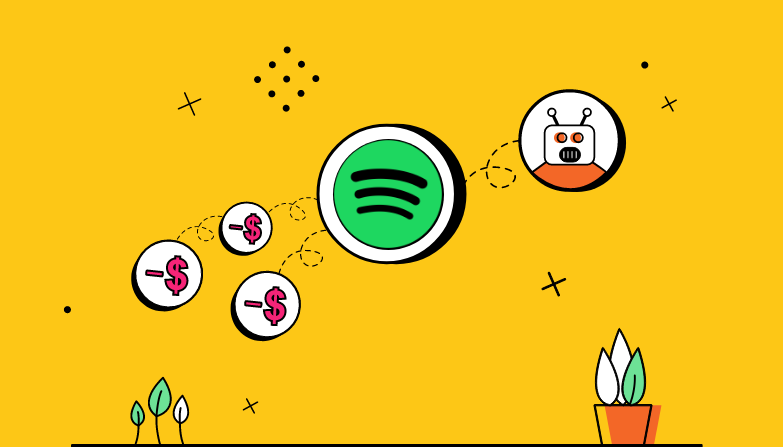In recent years, the rise of streaming farms has become a significant issue in the world of online streaming. This controversial business model has taken advantage of the constant hunt for more listeners, streams, and popularity among artists.
With a simple purchase of fake streams from streaming farms, it’s way easier now for artists to rank higher on the charts and gain more fans.
Without even mentioning it, we can only imagine the significant increase in revenue they receive from the royalties generated by all these streams.
And this is actually the most common reason why some artists decide to ‘invest’ in fake streams.
So let’s dive deeper and see what streaming farms are, how they work, and what they are used for.
What are streaming farms, and what are they used for?
Simply put, streaming farms are a network of devices, such as smartphones or computers. Their main goal is to play a specific song or piece of music to create the appearance of a large number of online listeners. These devices imitate human-like online listens and artificially increase streaming numbers.
This way, big artists and labels can fake their numbers on online streaming platforms like Spotify, Apple Music, SoundCloud, or Deezer and appear more popular than they really are. By doing so, these artists can stay on top of the charts and create music hits, which in return, of course, generates higher profits.
And here raises the question – are these artists and labels going against the principles of fair competition?
The practice of using stream farming gives artists an unfair advantage over smaller ones who may not have the ability or do not want to compete in this way. As a result, the music of smaller artists may remain undiscovered.
Let’s imagine that an artist has invested a huge amount of time to produce a quality piece of music in some genre. Another artist has a song that should be consumed by the same audience, but this artist uses a streaming farm to increase its popularity.
The higher number of streams then influences the streaming algorithms to recommend the song to real listeners, leaving the song by the other artist at the bottom. What this also leads to is that listeners may be presented with music that is less relevant to their preferences.
This way, streaming farms are not just disrupting fair competition but also are affecting the overall quality of the listening experience for users.
Cause and effect: The rise of online streaming and fake streams
Streaming services have undoubtedly played a crucial role in the survival of the music industry. In the past decade, the global revenue generated by sales of physical music products has decreased by a significant 35%.
However, the rise in popularity of online streaming has been staggering, and according to some music industry stats, now 65% of its revenue is coming from streaming platforms.
Usually, most of the streaming platforms have a free version, and there are paid versions as well. The paid versions are ads-free, and the platform earns money from monthly subscriptions. However, the vast majority of people use the free version. For it to remain free, they need to show advertisements.
So, same as social media platforms like Facebook, Instagram, or YouTube, streaming platforms also charge a certain amount of money for the number of ads shown.
On the other side are the artists and other rights holders who publish their work on Spotify or any other popular streaming platform. They earn from them through streaming royalties, which are payments made to them based on the number of times their music is streamed on the platform.
Naturally, the more streams an artist’s music receives, the more money they earn in royalties. And this is where the demand for streaming farms comes into play. Many artists turn to these shady boosters to artificially increase their streaming numbers and revenue.

Are music streaming farms illegal?
We’ll keep it short here. Yes. Similar to bot farms (which can be detected and blocked by ClickCease, as well as another type of farm fraud, click farms), they can harm healthy analytics on a huge scale and are affecting both advertising numbers and revenue streams for artists.
With the use of bot listeners on streaming platforms, advertisers are still paying for ads played to users who are not actually people. This leads to inflated numbers, ineffective use of advertising budgets, and a lack of accurate data.
Another major problem is that music labels and artists can make money from fake listeners of their music. While platforms like Spotify pay between $0.003 – $0.005 per stream, thousands of bot listeners can be purchased for less than a dollar.
Using music streaming farms violates Spotify’s terms of service and can result in penalties such as account suspension, legal action, and damage to an artist’s reputation. Ultimately, artists who use streaming farms steal money from the platform and other artists who will be paid less.
While Spotify and a few other streaming platforms have started including terms and conditions to take action against bot streams, it’s important for the industry to remain vigilant and prevent these fraudulent activities from occurring in the first place.
The controversy surrounding streaming farms
The use of streaming farms has become a major point of controversy within the music industry, raising ethical, financial, and legal concerns that demand closer examination.
When undetected, these fake music streams can create a distorted picture of an artist’s popularity and artificially inflate their streaming numbers. This affects the artists themselves and harms the credibility of the streaming platforms.
Streaming farms usually offer their services in the form of marketing activities focused on improving the promotion of artists’ songs or albums. Artists who use these forms to boost their streaming numbers easily rise in popularity. However, the level of this popularity is debatable.
They can’t ignore the fact that part of the streams come from the streaming bots they have paid for. Another part is that their music is recommended to real listeners due to the high number of streams. And it doesn’t have to mean that these real listeners actually like the song but have been just trapped within the auto-suggestion loop.
Nevertheless, some artists and labels don’t even care about organic fans. All they really need is the revenue they receive from the royalties. This way, they are taking the money away from other artists whose music might be much better but is suppressed thanks to the fake numbers of their competition.
This leads us to the conclusion that streaming farms can cause several negative effects, including:
- Misrepresentation of audience
- Unfair revenue distribution of royalties
- A distorted picture of the popularity
- Ineffective advertising on streaming platforms
- Unethical competition
- Harming streaming platforms’ credibility
- Manipulating trends in the music industry
In this era where online streaming dominates the music industry, it’s crucial for artists, labels, and streaming platforms to work together to combat artificial streams and promote authenticity, fairness, and transparency.
The future of stream farming
The rise of music streaming platforms has completely revolutionized the way we consume media. One of the latest trends in the music industry is that the number of accounts on streaming platforms (both paid and free) is continually growing.
For example, the number of paid subscribers quickly jumped to 616.2 million people globally in 2022. This is an increase of 93 million from 2021. Digital streaming holds 65% of the total revenue in the music industry for 2022 and is projected to reach 31.4 billion by 2027.
With this exponential growth, there’s no doubt that the streaming farms will try to catch up with the trend and simultaneously secure their growth. As the number of listeners on streaming platforms continues to grow, the competition among artists to maintain their top positions may become increasingly intense. In this fierce battle for attention, some artists will likely turn to alternative ways of boosting their streaming numbers.
This will lead to even more expressed negative effects in the industry, from misrepresenting audience and popularity to distorting revenue distribution and manipulating trends, increasing disappointment among the artists.
And who knows, it’s highly possible that this can also negatively affect the quality of the music we listen to, even though many of us will agree that this is already happening, especially in the past decade.

Bottom line
Essentially, a streaming farm is just a place with many digital devices. Each device is logged into a different account on one or more streaming platforms, and those streaming bots are used to play music 24/7.
Due to that, they directly impact the streaming numbers and manipulate the charts and playlists. This results in unfair competition among artists, affecting the discoverability and visibility of legitimate artists who are not using such tactics.
Additionally, fake listeners are generating higher revenue for artists and labels that use this fraudulent activity. This practice not only cheats the streaming platforms but also harms the overall streaming music industry by distorting data and preventing other artists from getting the recognition and exposure they deserve.
Block fraud with ClickCease. Start a 7-day free trial.
